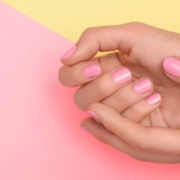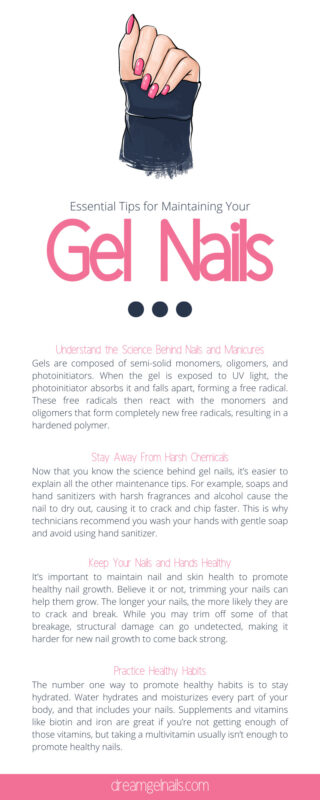5 Essential Tips for Maintaining Your Gel Nails
Gel nails were invented in the late 1970s by Dr. Stuart Nordstrom and reached the consumer market in the 1980s. However, his invention met with little success because most technicians did not know how to apply a gel manicure properly. However, in the 1990s, gel nails took off when manufacturers improved their formula and educated nail technicians on how to apply and cure gel nails.
Ever since then, the world of manicures has forever changed, and different manicure services as well as artificial nails of all shapes and sizes have skyrocketed in popularity. Technicians have embraced alternative forms of creative expression through gel application, artificial nails, and nail art. Technicians at high-end salons spend hundreds of hours perfecting their craft, creating intricate details and gilded nails to create custom and high-quality manicures.
This time and dedication are reflected in the expense of a gel manicure, and often why so many people try to find hacks to keep their set lasting longer. To help you keep your masterpiece lasting longer, here are five essential tips for maintaining your gel nails.
Understand the Science Behind Nails and Manicures
The best way to conquer something is to fully understand it. It may not seem pertinent to know how gel nails work, but understanding the application process and the science behind it can equip you with knowledge on how to better take care of your manicure as well as the importance of nail maintenance.
Gels are composed of semi-solid monomers, oligomers, and photoinitiators. When the gel is exposed to UV light, the photoinitiator absorbs it and falls apart, forming a free radical. These free radicals then react with the monomers and oligomers that form completely new free radicals, resulting in a hardened polymer.
If all of that was way too much chemistry, put more simply, the UV light makes the photoinitiator molecule split up. Then, because all the molecules want to be balanced, they’ll reach out to one another in a frenzy to gain back the atom they lost and end up forming a tough polymer chain.
So why is all of this chemistry important? It’s because this specific design was crafted for people who wanted manicures but couldn’t stand the consistent harsh chemicals of regular polish. The process of photoinitiation and curing with UV light is much safer and less harsh on the skin and nails.
The best way to maintain your gel manicure is to get gel manicures consistently. Changing up what kind of manicure you get too often can damage your nail, especially if you’re sensitive to other manicures; you can’t put a gel manicure on a damaged nail, as it can quickly lead to infection and nail bed damage.
Stay Away From Harsh Chemicals
Now that you know the science behind gel nails, it’s easier to explain all the other maintenance tips. For example, soaps and hand sanitizers with harsh fragrances and alcohol cause the nail to dry out, causing it to crack and chip faster. This is why technicians recommend you wash your hands with gentle soap and avoid using hand sanitizer.
It’s common knowledge that one of the common ways to remove nail polish is to soak the nails in acetone. Unfortunately, acetone and alcohol have the same chemical composition– carbon, hydrogen, and oxygen. So it stands to reason that alcohol can seriously damage your manicure. In fact, most technicians will advise against using acetone to remove your manicure.
While you can use acetone, it also dries out the nail and the nail bed, making your nail more susceptible to cracks and splits. Instead, file your gel polish down to remove some of the layers—just remember to only file in one direction. Next, use a non-acetone-based gel polish solution to further remove the layers and soak your nails in warm oil and water. Afterward, you can peel off any remaining gel.
With this method, you can ensure that you’re not drying out your nails and damaging the overall structure.
Keep Your Nails and Hands Healthy
It’s important to maintain nail and skin health to promote healthy nail growth. Believe it or not, trimming your nails can help them grow. The longer your nails, the more likely they are to crack and break. While you may trim off some of that breakage, structural damage can go undetected, making it harder for new nail growth to come back strong.
This means that you’ll also want to avoid picking at your nails, and yes, that means your cuticles and the skin around your nails as well! The skin around your nails and the cuticle prevent bacteria from getting into the nail bed. If you pick off your nail’s barrier, it can lead to a nasty infection.
While rare, a nail bed infection can mean losing the tip of your finger if left untreated. What may seem like a harmless, anxious habit can turn into a permanently damaged nail.
Cuticle oil and skin-sensitive hand creams are critical for keeping the skin on your hands and around your nail healthy. The stronger and healthier your nail barrier is, the stronger and healthier your actual nail will become. In addition, your manicure needs a healthy foundation to start on. Your technician should be using the proper gel base coat to protect your nail and start your manicure off strong.
Practice Healthy Habits
The number one way to promote healthy habits is to stay hydrated. Water hydrates and moisturizes every part of your body, and that includes your nails. Supplements and vitamins like biotin and iron are great if you’re not getting enough of those vitamins, but taking a multivitamin usually isn’t enough to promote healthy nails.
Protein-rich foods like meat, eggs, or nuts strengthen your nails, much like the iron in dark, leafy greens. Collagen is also good for your nails and the skin around your nails. Bone broth is a fast way to boost your collagen intake, but if you’re against eating animal products, there are hand masks derived from plant “collagen,” or fibers.
Know How To Manage a Broken Nail
If you’re avoiding harsh chemicals and practicing good nail health, but your nail still cracks, then you need to know how to perform a manicure emergency overhaul to avoid any more structural damage to your nail! This may happen for a number of reasons that aren’t necessarily your fault, especially if the gel polish is too thick toward the edge of the nail. But don’t worry! While you can’t glue your nail back on, you can still smooth it out and make sure the nail grows back properly for your next manicure.
First, you have two different choices: you can either trim the whole nail or trim the part that is chipped off. Either way, try to make it even for the next step. After trimming, take a fine-grit emery board and file in one motion, as a back-and-forth motion makes micro-splints.
If you’re only trying to manage a crack, a professional can fill it in with nail powder or use nail glue to keep it in place to prevent any more breakage.
Ultimately, the best tip for maintaining your gel nails is to take care of your nails themselves. Manicures need a good foundation in order to last long. Without a healthy foundation, your manicure will crack and fall apart. So start practicing nail health today and make sure your beautiful manicure lasts for weeks to come!




